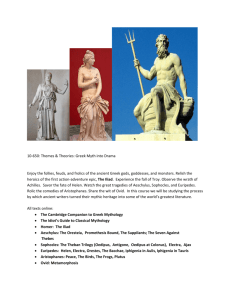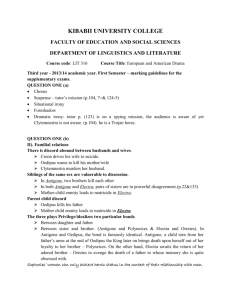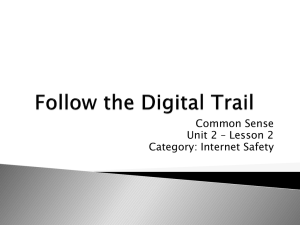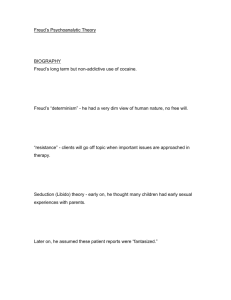“The House of Atreus in Cyberspace: Gender Battles Revisited on
advertisement
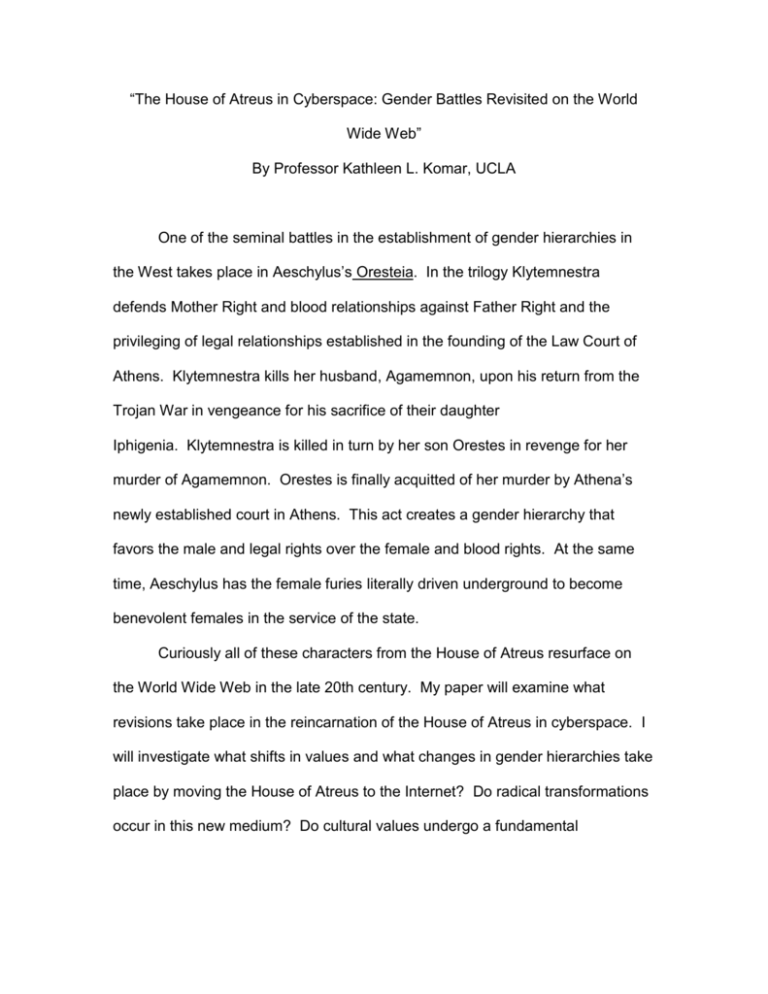
“The House of Atreus in Cyberspace: Gender Battles Revisited on the World Wide Web” By Professor Kathleen L. Komar, UCLA One of the seminal battles in the establishment of gender hierarchies in the West takes place in Aeschylus’s Oresteia. In the trilogy Klytemnestra defends Mother Right and blood relationships against Father Right and the privileging of legal relationships established in the founding of the Law Court of Athens. Klytemnestra kills her husband, Agamemnon, upon his return from the Trojan War in vengeance for his sacrifice of their daughter Iphigenia. Klytemnestra is killed in turn by her son Orestes in revenge for her murder of Agamemnon. Orestes is finally acquitted of her murder by Athena’s newly established court in Athens. This act creates a gender hierarchy that favors the male and legal rights over the female and blood rights. At the same time, Aeschylus has the female furies literally driven underground to become benevolent females in the service of the state. Curiously all of these characters from the House of Atreus resurface on the World Wide Web in the late 20th century. My paper will examine what revisions take place in the reincarnation of the House of Atreus in cyberspace. I will investigate what shifts in values and what changes in gender hierarchies take place by moving the House of Atreus to the Internet? Do radical transformations occur in this new medium? Do cultural values undergo a fundamental 2 rethinking? Are literary characters and motifs drastically revalued? These are the questions I will investigate. Myriad web sites have been dedicated to various members of the House of Atreus--including: Electra.com, Iphigenia.com, and Orestes.com. Agamemnon.com was still available when I first checked in 1999. By June 2000 the site had become Agamemnon Film, owned (appropriately, I think) by Charlton Heston and his son Fraser. Even Atreus.com appears as a web-page design company. Orestes’ website gives some indication of the attraction his name still holds even though his story has been obscured. Orestes.com. turned out to be the homepage for a Finnish media agency that designs websites for other businesses. When I asked the webmaster, Tapio Nissilä, how he chose the name Orestes, he responded (in an email of 7/23/99) that the name was chosen more or less “randomly.” The Finnish company needed an “international” name (i.e., not identifiably Finnish) and Orestes “sounded attractive.” Orestes name still holds cultural weight, even though the Finnish group was clearly unaware of his actual story. Because I inquired, the company researched Orestes’ story and began to worry. Mr. Nissilä expressed the hope that “our name is not any kind of offence to you or any other person interested in ancient mythology” (email 7/23/99). He went on to say, “I can now see that there is a small contradiction [in the choice of names], at least from your point of view.” I assured him that I was fascinated rather than offended since the website began with a handsome, welldressed young man who looked as though he was in charge of a business. This 3 might be appropriate for a late twentieth-century Orestes--a new kind of economic king for a rising group of young entrepreneurs in a stock market gone wild at the end of the millennium. However, the group did, in fact, change their name to “Identia.com” in May of 2000. I was torn between feeling that I may have struck a blow against patriarchy and feeling sorry that I had removed a classical figure from cyberspace. The males from the House of Atreus, Agamemnon and his son Orestes, thus land on the internet in eponymous websites that maintain their masculine appeal—either as contemporary macho screen figures like Charleton Heston (famous for playing other patriarchs like Moses) or as young entrepreneurs and business leaders. Interestingly, the avenging and vengeful mother Klytemnestra is the only one in the immediate family to lack a website of her own. i Perhaps an axe-swinging female persona who kills husband and king is one that neither men nor women care to immortalize in cyberspace. While Orestes’ murder of his mother apparently did not blacken his name in the website arena, Klytemnestra’s murder of her husband clearly did. The gender hierarchies established in their original story seem to be alive and well. Although Klytemnestra dominated narrative texts and stage performances in the 1980s, the cultural scene—and cyberspace--both favor her daughters in the 1990s.ii The move from the 1980s to 1990s marks a shift in interest for women revisionist writers in particular from Klytemnestra and her founding battle for female rights against a rising patriarchal order to her daughters, Electra and Iphigenia—both of whom defend the very patriarchal order that Klytemnestra 4 battled against. Her daughters, Elektra and Iphigenia, do (or rather didiii) have their own eponymous sites. Both of the sites I will discuss here have since vanished along with the millennium or been replaced by new domain owners. To provide the briefest of classical contexts for Klytemnestra’s offspring, Electra and Iphigenia are the daughters of Agamemnon and Klytemnestra and sisters of Orestes. Iphigenia is sacrificed by Agamemnon when the Greek fleet that he commands is becalmed on the way to Troy.iv Klytemnestra will later slay Agamemnon on his return from Troy in retribution for her daughter’s murder.v In one version of Iphigenia’s story, she is saved by Artemis and later reunited with her brother, Orestes.vi Klytemnestra never finds this out, however. After killing her husband, Klytemnestra treats her daughter Electra badly. Electra loudly bewails her fate and waits for the return of Orestes to seek her own vengeance for their father’s death. She and Orestes plot to kill their mother, and Orestes carries out the deed.vii Both Iphigenia, by accepting her sacrifice for the good of the Greeks, and Electra, by avenging her father and the patriarchal order at the cost of her mother’s life, support the rising patriarchal system that their mother fought. Perhaps the most fitting “re-inscription” of Electra as the millennium came to a close was electronic.viii Of all of Klytemnestra’s progeny, Electra, the rebel daughter who stands up for (male) right and for her betrayed father, who breaks free of her mother’s domination in order to mourn her father and find a life of her own seemed most attractive in the late 1990s. Given Elektra’s popularity, Klytemnestra was still seen as the betraying and murderous wife, the destructive 5 woman. But Elektra elicited passionate sympathy, admired for her irrepressible determination and loyalty. This kind of admiration—generated partly by the revival of Electra on Broadwayix--made Electra a recognizable and positive icon, whose name was sufficiently well known to merit being used for a website. Electra, alone among Klytemnestra’s daughters, conquered the internet by having a virtual empire built in her name as the millennium closed.x Described in a Time digital article as a “hip women’s site,”xi The Electra.com of the late 1990s began (at least in the week when I first visited the site in March 1999) quite unintentionally ironically with an 1950s-vintage drawing of a mother hugging her baby daughter next to the quotation, “Your Mom wanted the best for you, don’t you deserve it?” with the name Electra in bold and highlighted beneath the quotation. (See a sample page from the website at the end of this essay.) The authors of this site are clearly not troubled by (or apparently aware of) the classical legends that attend Electra and her “Mom.” The site is practically oriented, flanking the vision of a loving mom with an ad for online health insurance. The site does, however, capture some of the ancient Electra’s intensity and focus. In a section entitled “Simplify Your Life,” the site suggests that “Electra helps you define what’s important and weed out the rest.”xii This ability was certainly one evidenced by the ancient Electra, whose singleminded focus on her mother’s destruction became legendary. While she does indeed present a strong and successful female character, the ancient Electra is a much more troubled figure than her late twentieth-century counterpart. The end of the last millennium managed to remove Electra’s 6 trauma-inducing mother, Klytemnestra, entirely in favor of a more unproblematically loving “mom.” Electra becomes the image of the strong and accomplished woman; the fact that she works entirely in the service of the male order in the classical texts has disappeared in the website along with her desire to execute mom. In short, despite her interactive mode, this 1999 Electra has become rather one-dimensional. In many ways Electra’s sister Chrysothemis might be a better figure for this website (provided anyone today who was not a classics scholar would recognize her name). With all the advice on money, career, relationships, women’s health and dating that the Electra.com website offers, it would be easier to picture the good and dutiful daughter Chrysothemis exploring its frames than the raging Electra. Both Klytemnestra and her rebellious daughter Electra have been tamed and domesticated here, as have the other forces at work in Greek tragedy. Fate and the manipulative gods have been replaced by astrological forecasts. “Are there invisible forces affecting your life?” the website asks. Yes, but Apollo, Athena and the curse of the House of Atreus have been replaced by our daily astrological chart. We can no longer claim, as the classical Orestes did after slaying Klytemnestra, that a god made us do it. We live in a less divine but perhaps more trivially superstitious universe than the ancient Klytemnestra. This website implies that our fates concern small personal events such as dating, personal health and hygiene, finding a job; our personal actions do not often rise to the public and political power generated by the classical Klytemnestra or Electra. As the last millennium came to an end, women (at least as defined by 7 this website) seem to have hunkered down or “cocooned” at home, more comfortable with Martha Stewart (before her fall from grace) as a role model than Klytemnestra--or the ancient Electra. Although Electra’s website talks about women who have acted in history and politics, it is geared to women who focus on home. Like her Furies, Klytemnestra is tamed here; she becomes again the peaceful keeper of the hearth, the good mate and mother. This is Aeschylus’s Eumenides writ small--or rather, writ electronic. Electra has undergone a serious metamorphosis as the twentieth century closed. The classical figure who endlessly mourns at her father’s grave and demands her mother’s death has taken to listing jobs, “temping for a living,” and reading horoscopes about dating. Electra does, however, gain one important feature in the late twentieth century; she replaces her much-loved sister Iphigenia. It is as though Klytemnestra’s story has been rewound to a point before the loss of her daughter. The doting mother again holds her loved daughter and “wants the best for her.” The daughter, however, has changed from Iphigenia to Electra. This sibling replacement represents a wish fulfillment for Electra.xiii Like her sister Iphigenia, who, at least in Euripides’ version, comes to accept her fate as sacrifice to the war and male aspirations, Electra too supports her father and the male power structure. Like Iphigenia’s death, Electra’s success in killing her mother helps reaffirm the patriarchy. But if Electra is taken back to a time before Klytemnestra’s loss and rage and installed as the cherished child, Electra’s strong will and spirit could be nurtured by female love. 8 Electra would then become the daughter she may have wanted to be, and Klytemnestra would become a mother she could love in return. The implication here is that a viable family unit has been reestablished without Aeschylus’s battle to the death between Mother Right and father’s law. Interestingly, however, the Electra.com website does not mention the father at all. He has been displaced and replaced by a loyalty to the mother. In fact, the whole Electra.com world becomes a female domain. Men are mentioned only as potential dates or mates. One article is even entitled “Token Male: A man’s point of view in a woman’s world.” But this women’s world has contracted drastically from that in which the ancient Klytemnestra and Electra operated. Electra.com has created a world geared to female “18-to-34-year-olds,” who will find the perfect mate, attract him with the perfect body (having attained it by knowing the really low-fat foods), and raise happy families while holding down a not-too-highpressure job and investing for retirement. Issues of power, politics, struggles for dominance, and most crucially, the conflict between home and public arena are all airbrushed out of this reassuring picture. If fate exists, it can be read in an astrological chart. In this world, female children are not sacrificed for war nor suppressed by their mothers. Mom has never touched an axe nor would she think of neglecting one child for another. Electra has moved to a reassuring, safe fantasyland and taken her mother, Klytemnestra, with her.xiv It is not surprising, therefore, that Electra.com was filled with articles on “Home How-To’s,” “Lowfat life,” and “The Dating Diva.” As the millennium drew to a close, the world of the classical Klytemnestra and Electra contracted back 9 into the home. The Furies are tamed by helpful psychiatric hints, women learn to be well-adjusted wives and mothers who can hold down a job and tend the family simultaneously. The shrill, critical, female voices of feminists of the 1970s and 1980s became cheerier and more optimistic in the late 1990s--largely by constricting women’s field of vision. Although this is a “women’s world” backed by en extremely powerful media business woman (Gerry Laybourne), it seems to cater to rather than challenge the patriarchal arrangement of western culture. Given the discovery of an Electra online, a search for her sisters was irresistible. Unlike Electra, Iphigenia did not enjoy the massive corporate backing of (oxygen)media.inc. She was depicted on her website as a lone figure, carrying what seems to be an ancient dramatic mask, and accompanied by a single poem entitled “Iphigenia.”xv The poem is copyright 1999 to S. dePackh from “Women’s Work.” xvi dePackh’s poem explores Iphigenia’s identity--as Agamemnon’s daughter, sacrificed at his hand. Strangely it never mentions the mother who would risk so much and suffer so much to avenge her. In this website too, Klytemnestra has been entirely displaced by her daughter. In a particularly dialogized mode, the poem recalls Iphigenia’s variable story--as saved priestess of Artemis in Tauris or as the gagged, voiceless sacrifice of Agamemnon, which insured HIS glory, not hers. This Iphigenia cannot remember her own past; she interrogates her listeners/readers for answers. Clearly a questionable self always in process, this Iphigenia asks, “How many selves do I have?” She answers wisely “A self for every person who 10 makes a myth of me. A self for each one who looks to me for answers...” The website Iphigenia.com makes yet another myth for her to be. Iphigenia’s own center is a “whirlwind of blackness,” an emptiness needing to be filled with a content by those who would revive and understand her. She is a character who can only gain meaning in revision. This is a woman whose life was sacrifice and whose memory is pain. Everything about her existence is uncertain. Even her “would be” husband, Achilles, the famous hero, is shrouded in uncertainty as is his victim, Penthesilea: “Achilles who raped--- or didn’t--- killed--- or didn’t--- the Amazon queen Penthesilea--- who was thrown in the Scamander river--- or wasn’t--- but who is most certainly dead---” Always in “this same limbo of revised legends and tailored memories---,” Iphigenia is “unable to speak without a contradiction of echoes.” In short, this is a late-twentieth-century Iphigenia, akin to her aunt Helen in H.D.’s Helen in Egypt, xvii whose self must constantly be defined anew, whose life must unceasingly be filled with meaning if the whirlwind of blackness is not to conquer all. This Iphigenia demands to be rewritten, reinscribed in her own memory as well as in history. This is a much tougher vision than one encounters anywhere in Electra.com. No cheery optimism here, no advice on boyfriends or household chores, no health insurance for sale--just the hard work of remembering and of making meaning of those complex cultural memories. This Iphigenia knows the work is hard and that one might surrender the task and “turn away and disappear like mist---unable to bear the sight of this gash across [her] larynx--- this mark 11 that fills [her] words with blood and enfeebles the air behind them with the rushing sigh of loss.” dePackh’s Iphigenia does not support her father and her patriarchal fate (although she names her father, Agamemnon, her “would-be” husband, Achilles and her brother, Orestes, the males most crucial to her story without ever naming her mother or sisters). Although surrounded by the patriarchy and hardly in Electra’s “woman’s world,” this woman questions and challenges. She knows that her fate as female sacrifice for the glory and survival of the patriarchy is a shared one. She senses that many women have her feeling of loss and of perplexity. She ends by giving women a choice: “Forgive me--- if you care to. Leave me if you need to. Listen to me if you can. Hear me if you are brave and flexible--- or if you too wander this lonely place--- and your voice as well shudders and deadens and searches for resonance to penetrate this endless fog---.” For those who share her questioning of a self defined by sacrifice and violence in the patriarchal tradition, who seek some other meaning for their existence, who want to listen and to speak anew, Iphigenia is still available. Not totally lost in virtual reality, she still stands as a woman who would revise her legend, who questions the cultural icon who serenely goes to her death to support a war over male rights in marriage and eventually the founding of the western patriarchal tradition. Her voice may not be as far reaching as that projected by Electra’s backers, (oxygen)media.inc, but it may well be stronger. 12 There was still hope, it seems, that as the millennium ended female writers and artists had not simply forgotten women who suffer and inflict violence. Oddly, dePackh puts each reader in the position of the Klytemnestra so notably missing from this poem. We are asked to make sense of the violent sacrifice of a woman for the male power structure. The reader becomes a witness of the daughter’s pain; s/he is asked to create some coherence of this, to reinscribe a meaning that will restore a center to Iphigenia’s memory. The task of revision is reopened in dePackh’s poem as the century closes, and we ourselves occupy Klytemnestra’s empty position. dePackh forces us to ask again whether we can respond to Iphigenia’s death in some more constructive way, whether we can rewrite her sacrifice as the beginning of some other cultural and social possibility as a new millennium begins. Ironically, of those websites for the women of the House of Atreus who are reinscribed in cyberspace, it is the more traditionally “literary” piece, dePackh’s “Iphigenia” that issues a bigger challenge to traditional western gender hierarchies. For all its technical sophistication, Electra.com turns out to be rather unthinkingly traditional. Or perhaps it is a highly calculated business enterprise that plays off of rather than opposes gender assumptions. Like the Agamemnon.com and Orestes.com sites, Electra.com remains in the territory of familiar cultural assumptions, reinforcing either directly (for the male sites) or perhaps unconsciously in Electra’s case, the power relationships between the sexes. Floating in cyberspace does not in itself guarantee any radical activity. The “hip website for women” does nothing to modify the gender hierarchy in 13 which they are embedded, whereas the more humble, less techno savvy Iphigenia.com demands that we face and reconsider the gender power struggle that underpins western culture. Revealingly, however, the presence of Orestes, Agamemnon, Electra and Iphigenia on the World Wide Web with .com addresses indicates that the contemporary technological revolution is taking our founding cultural myths along with it into a new era. Klytemnestra’s story is preserved in most of its detail in her techno-trial; Agamemnon’s mission to Troy is cited on the film site run by Charlton Heston and his son. Iphigenia’s plight is aptly preserved in contemporary poetry and image. This interaction of ancient founding myths and absolutely contemporary technology indicates that culture continues to operate in an evolutionary mode--even if a radical one. While new cybergames appear, “high culture” infiltrates the web matrix to keep alive the narrative explorations of our most crucial cultural tensions. The political and cultural power struggle between men and women remains embedded in the subtexts of websites that invoke classical characters and myths. In sites such as Iphigenia.com, the ethical questions concerning the founding moments of western culture persist-atomized and dialogized--, but virtually intact as we venture onto the internet superhighway. A second type of cultural incorporation in cyberspace is embodied in Electra.com. In this case only an echo of any ancient story remains--and that a faint one. Electra has metamorphosed into a later self who does participate in power and does share the kingdom. Her ancient self is no longer recognizable except as the powerfully focused and ambitious young woman who succeeds in enacting her will despite all obstacles. Unlike her mother, Klytemnestra, whose story reaches the Web almost in its entirety in “The People versus Clytemnestra,” 14 Electra becomes a vaguely positive invocation of the female with the details of her drama lost to view. Her homophonic relationship to electricity--and their etymological resonances of meteoric qualities and production of energy by friction--help Electra to gain footing in a new cultural arena that remains largely unaware of her heritage. This lack of genealogy may make sites like Electra.com more available for forging new female selves not staked to a traumatic past. Or such sites may indicate that contemporary young women remain unaware of the gender power struggles that shaped the western tradition—or unconcerned with such “ancient history.” Orestes inclusion in cyberspace representes yet a third kind of relationship of “high culture” and founding cultural models to the contemporary technological revolution. Orestes’ name was used as a .com label without any real awareness of his cultural past on the part of those mounting the website. Once aware of Orestes’ story, however, his .com webmasters decided to change the name of their website to “Identia.com.” Having eliminated Orestes’ perplexing persona, Identia declares it’s mission to be “to carry our client’s identity to the new medias.”xviii Orestes’ identity is replaced by that of the client (depicted dominantly as male), the consumer of technology. It is telling that Orestes still makes people so uncomfortable that knowing his story makes him too problematic to be used as any kind of logo figure. The difficulty of making Orestes’ murder of his mother palatable to western culture seems to remain insurmountable even on the internet. In any case, he is ousted from his place in cyberspace to be replaced by the interactive client of web technology. Following the House of Atreus from its beginning in ancient Greece to the Internet allows us to begin to explore the complex interaction of “high culture” as embodied in founding texts such as the Oresteia and the new technology and power economies that shape western culture as the new millennium begins. 15 Indeed, this journey demands that we reconsider many of our founding cultural moments--particularly those that have to do with fundamental gender tensions like those played out in the conflicts of the House of Atreus. Postscript One more note must be added in concluding this discussion: both Electra.com and Iphigenia.com have been swallowed by larger websites in the last few years. Iphigenia.com seems to have been subsumed under a larger site that is still under construction. Typing in www.iphigenia.com takes you to a website run by Jason Reast-Jones who has a British web address. This site seems to be a workshop of creative people who contribute photos, drawings and essays. I could not find any trace of Iphigenia at all. When I inquired of the Webmaster, Jason Reast-Jones responded that he bought Iphigenia.com in 2001 as a gift for a friend who was very interested in the myth “with a view to creating a nice info center on the Heroine. Sadly this never transpired & alas Iphigenia.com remains empty” (email of 4/25/2002). Mr. Reast-Jones and his friend intend to return Iphigenia.com to the Domain pool when their lease expires. I am curious to see what she might turn into next. I followed Electra.com through a more circuitous route. Electra.com first moved under Oprah.com, Oprah Winfrey’s website that supplies many of the same kinds of articles and information about personal fulfillment, fitness and lifestyle that Electra.com used to provide. I can only surmise that Oprah provides a much more recognizable role model than Electra used to. Indeed, if Electra 16 has metamorphosed into Oprah, we find her reembodied in a woman of considerable power, wealth and control, who focuses on women and their lives but has reintroduced a male voice in the form of a popular psychologist, Dr. Phil (who has since spun off into his own self-help television show).xix Perhaps we are witnessing a reintegration of the male and female in a newly conceived world where women seem quite able to hold the kingdom of television or the internet. Oprah, who herself had to overcome an abusive father, revises the picture by introducing a new male authority who works for and with women. Perhaps the post-modern mélange of cultural shards has resolved into a 21st-century rebuilding of the kingdom of women. While this metamorphosis may present a note of optimism regarding the roles and power of women, it also displaces the classical names and figures totally. By April 2002, no traces of Electre.com remained. We were no longer led to Oprah through Electra; her name became a dead end. I did still in April 2002 locate some sites related to Electra—including a rock band named “Writhing Electra,” which can be reached at www.writhingelectra.com and has a soulful female lead singer backed (appropriately) by three male colleagues. While lyrics such as “Standin’ and Cryin’” do invoke some memories of Electra, they are very faint ones indeed. I also found a Scottish security company (www.electra-com.uk.com) and a Czech Internet café (www.electra.cz), which seem interested primarily in the homophonic connection of Electra. In short, Electra disappeared entirely by mid 2002—only to reappear eventually under two different guises. Elektra.com is currently a rock music site 17 featuring groups such as Phish and undoubtedly playing on “electric.” The second incarnation is more troubling. Under Elektra.org is a site that aims to help families in crisis because a child has a life-threatening illness. The site begins “Elektra’s House—Her Magic Lives on.” Although there is no direct reference to the classical Elektra, one can only wonder if this is the persona whose magic lives on in an intensely family-oriented site while she herself either dismantled families (in helping to kill her mother) or was notably deprived of one herself. Appended Material follows 1. Sample page from Electra.com 2. The entire website for Iphigenia.com 18 19 20 21 i Curiously, while Klytemnestra’s daughters, Electra and Iphigenia, each have a “.com” address as does her son, Orestes, Klytemnestra herself lacks an 22 electronic address in the 1990s. (When I checked in December of 2004, both Clytemnestra.com and Klytemnestra.com were still available.) Although Klytemnestra does not have her own “.com” address, one of the most fascinating and confusing revisions of her story entitled ,”The People versus Clytemnestra,” can be visited at http://members.tripod.com/NWO_2/index.html. On this site a new worldwide web of connections envelops Klytemnestra. Technology and popular culture collide with high literature and some of the founding mythical texts of the Western tradition. For an analysis of this website, see my volume Reclaiming Klytemnestra, University of Illinois Press, 2003. iiSee my volume Reclaiming Klytemnestra: Revenge or Reconciliation. The study focuses on the battle between Mother Right and the newly arising patriarchal law as depicted in Aeschylus’s Oresteia and replayed by a number of contemporary women writers in the 1980s. The past tense here is due to the fluid nature of the world wide web on iii which websites appear and disappear over time iv See Euripides’ Iphigenia in Aulis (c405 BC). v See Aeschylus’s Oresteia (458 BC) for Klytemnestra’s, Electra’s and Orestes’ actions. vi See Euripides’ Iphigenia in Tauris (c414-412 BC). vii See Euripides’ Electra (413 BC) and Sophocles’ Electra (414? BC) for two different interpretations of these events. 23 viiiOne wonders if the aural proximity of Electra’s name to “electric” or “electronic” contributes to its choice as a title for Electra.com. I attempted several times to contact both Gerry Laybourne and the webmaster for Electra.com to get more information on the choice of names for the site, but I got no response. ix Frank McGuinness’s adaptation of Sophocles’ Electra under the direction of David Leveaux ran quite successfully on Broadway and was nominated for several Tony Awards. The play, which debuted at the Ethel Barrymore Theater on West 47th Street in New York in December of 1998 and was to have run until Jan 17, 1999, was extended for several months due to overwhelming demand for tickets. In the 1990s, the House of Atreus was reviving in several areas of the country and in varied artistic media. Garrett Fisher’s opera Agamemnon, which uses Taiko drummers as well as and masks, played in Seattle’s Nippon Kan Theater in June of 1998. Euripides’ Orestes was revived in April and May of 1998 at the Franklin College Theater in Indiana. Playwright Ellen McLaughlin staged Iphigenia and Other Daughters at New York’s Classic Stage Company in 1995, and Ruth Margraff presented an opera, The Elektra Fugues in New York’s HERE Theater in 1997, which was later done as a play in Culver City, California in 1999. The Greeks, an adaptation by Kenneth Cavander based on Euripides, Aeschylus and Sophocles and commissioned by the Royal Shakespeare in 1980, ran in Los Angeles in a sixhour production in September, 1999. 24 x Iphigenia.com was a single poem that will be discussed below. xi Anita Hamilton, “Geraldine Laybourne Brings Women a Breath of Fresh Air,” in Time digital, March 1999, 23-24. Time digital is actually a printed magazine with an accompanying website (www.timedigital.com), distributed by Time magazine and featuring technical and internet materials. Its subtitle is “Your Guide to Personal Technology.” xii All of my quotations here are taken from the Electra.com website of March 20, 1999. xiii This precise move was anticipated in Séverine Auffret’s study 15 years earlier. See Séverine Auffret’s Nous, Clytemnestre: Du tragique et des masques. Paris: des femmes, 1984. Auffret predicts just such a development in her study of Klytemnestra. xiv Strangely enough, Electra.com was part of a new media empire aimed at a female audience and meant to announce a new woman for the new millennium. Tracing Electra.com back to its mother organization by links on its screens, I discovered a group called (oxygen)media, inc. headed by Gerry Laybourne. This group, as its manifesto asserted in 1999, was out to create a new vision of media for the millennium. It declared its audience to be “women of the Millennium” and their children. These groups were identified as “choked by stale content” of television and the Internet and seeking a breath of new air-enter (Oxygen)media, inc. Oxygen originally had a variety of websites for healthy 25 living (thrive.com) and women (electra.com and momsonline.com); it was associated with the Walt Disney Company, America On line, Carsey-WernerMandabach (an independent production company responsible for television shows such as “Roseanne,” “Cybill,” and “Grace Under Fire”), and finally Oprah Winfrey and her HARPO Entertainment Group. Surprisingly well connected, then, (oxygen)media, inc. was the vision of its director, Gerry Laybourne, who was featured prominently on the oxygen.com website--even down to pictures of her hairstyle and its changes over the years. Gerry was the self-declared arbiter of what women wanted in 1999 and in the new millennium. Given her ability to produce high-quality programming for children on the Nickelodeon channel, she was obviously an important voice in media at the end of the last millennium. Some of what she says is interesting; some of it gives one pause. Her stress on the economic capabilities of women provided useful data. (In her website pages entitled “The Facts,” which presents data on women, Laybourne pointed out, for example, that “American women are, in effect, the largest ‘national’ economy on earth.”) Laybourne sees the leadership style of the 21st century being described by words “more typically feminine,” such as: collaborative, flexible, celebratory, encouraging, personal, rewarding, open, “we”-oriented. This assertion is somewhat difficult to accept. How do Klytemnestra and her late-twentieth-century offspring fit into to the open, collaborative, encouraging, vision that Laybourne sees for the 21st century? While I may agree that such a leadership style is desirable, I cannot see it as 26 “more typically feminine.” This seems to be a “feminism” that wants the world to be less complicated. (oxygen)media.com created a feel-better-about-yourself, self-help guide to living for a female audience. It provided some uplifting (and some silly) information for women. But while it did include some economic issues, it tended to focus on women as consumers of media (“spending 8.8 hours per day with some form of media” according to Laybourne’s “Fact Sheet”) or as wives and mothers. It seemed mostly unconcerned with politics or issues of power in a larger social arena than that of personal relationships. xv See insert above for the entire website. xvi Selene dePackh responded to queries to her website in a letter from her home in Pittsburgh in which she explained that her interest in Iphigenia was “a childhood grounding in myth combined with experiences that led me to empathize with Iphigenia’s perspective” (from a single-page letter from Selene dePackh to Kathleen L. Komar, dated 7/4/99). dePackh founded a gallery, named “Women’s Work,” composed of women’s art “from a feminist/survivor standpoint” (letter, 1). Although the Pittsburgh area could not support the gallery for long, dePackh kept the website for as long as she could with the help of interns from Pitt Women’s Studies. Although her gallery patrons “criticized [her] for making too many obscure mythological references in [her] work” (letter, 1), dePackh decided to put her “true voice out into the wilderness and see if anyone 27 would answer” (letter, 1). Apparently, I was one of the few hits on the Iphigenia.com website who contacted the poet directly. I can assure her that her “obscure mythological references” put her into the company of some very reputable women re-visionist writers and artists. xvii xviii D(oolittle), H(ilda). Helen in Egypt. New York: New Directions, 1961. Quoted from the Idenita.com website on June 30, 2000. See www.identia.fi/en/uutiset/identia1.shtml. Dr. Phil is Dr. Phil McGraw, with a degree from North Texas State xix (according to Oprah’s website under “About Dr. Phil McGraw.”) Dr. Phil is a consultant to corporations on “life strategies” and provides advice to Oprah’s viewers and web visitors on how to conduct one’s life or how to reform bad habits in order to reach happiness. He eventually got his own television show that became a smash hit by 2003. His guests and “patients” (as well as his audience) are overwhelmingly women.
